Don M. Winn's Blog, page 3
June 9, 2022
Audiobooks, Dyslexia, and the Brain
Audiobooks, Dyslexia, and the Brain
You can listen to this blog.Some people wonder if audiobooks are a “legit” way for dyslexic students to read? A recent conversation with a frustrated parent led me to look for a way to help. The parent’s question was about the “legitimacy” of using audiobooks for school assignments versus reading the material. Their school district was not supportive. The struggling student’s dyslexia wasn’t diagnosed until fifth grade, so the child’s reading skills are years behind. And while all involved are keen to see the student get caught up to grade level in reading speed and comprehension, few accommodations are being offered.
So it got me thinking: What are the effects of audiobooks on dyslexia and the brain? Are there any studies that compare how the brain works when reading print versus listening to someone read the material? Turns out, there are. The most helpful study was published in the Journal of Neuroscience in 2019, entitled, “The Representation of Semantic Information Across Human Cerebral Cortex During Listening Versus Reading Is Invariant to Stimulus Modality.”
What does this mean when translated?
It means that science has confirmed through brain scans that whether someone is reading the printed word or listening to the same word in audio format, the brain areas that “light up” with cognition and emotion are virtually identical.
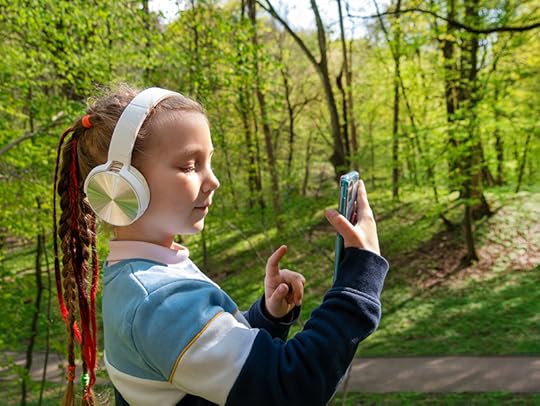
Scientists at the University of California-Berkely put volunteers into fMRI machines and had them listen to a podcaster reading stories. They then repeated the brain scan while the volunteers read the same stories in printed form. Both scans were time-stamped and aligned so that the researchers could pinpoint specific words from both scans and map the regions of the brain as they responded to specific words like names of animals and even phonemes (individual sounds that make up words).
The maps of the volunteers’ brains were so accurate that researchers could predict which regions would activate based on upcoming words, and those predictions held true whether the words were heard or read.
For the struggling reader, this study has real meaning. Why? Because hearing the words in required reading assignments activates their brain, improves vocabulary, and allows them to connect with the joy of great stories—all of which provide the stimulation and encouragement a struggling reader needs to persevere!
Of course, learning to read print is always the goal. Always. By starting with audiobooks and following along with the print or digital book(s), the student trains their brain while taking the pressure off when reading grade-level material. Less pressure equals a less stressful learning environment, which gives the child’s brain increased bandwidth for catching up on their crucial skills. Articles like this one are a great tool in your advocacy toolbox!
Thanks for reading about audiobooks, dyslexia, and the brain. Here are the links to the research study for you to reference if needed (they both link to the same article):
https://www.jneurosci.org/content/39/39/7722
-or-
DOI: https://doi.org/10.1523/JNEUROSCI.0675-19.2019
—-
For a thorough discussion of dyslexia, you may enjoy the second edition of my award-winning book Raising a Child with Dyslexia: What Every Parent Needs to Know, available in softcover, hardcover, eBook, and audio. In addition to facts on testing and accommodation, my book gives you the tools to provide the social and emotional support children with dyslexia require. The second edition has the same great content as the first edition but now contains a very helpful bibliography and index and an exciting new cover.
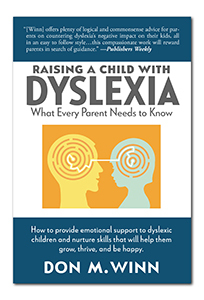
And to learn more about how every student best learns to read, you may also enjoy Failing Students or Failing Schools? A Parent’s Guide to Reading Instruction and Intervention, by reading specialist and shortlisted World Literacy Award nominee Faith Borkowsky.
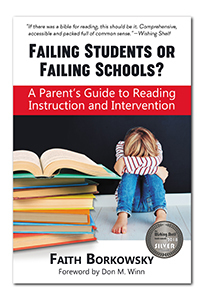
Cardboard Box Adventures picture books are great for shared reading and can help parents establish a strong preliteracy foundation for their children. Check out the CBA Catalog for a full list of award-winning picture books, chapter books, and resources for parents and educators. Visit my Amazon author page for more information.
The post Audiobooks, Dyslexia, and the Brain appeared first on Author Don Winn's Blog.
May 24, 2022
How Reading Shapes the Brain
How Reading Shapes the Brain
You can listen to this blog.The other day I came across a quote that stopped me in my tracks. It read, “Reading is everything, and saying so is more than an inspirational slogan. It’s now a definitive research conclusion.”
Well, as you can imagine, I couldn’t just let that little nugget sit there. I needed to take a deeper dive and learn about the person responsible for those stunning words, because it led me to think that there is more to how reading shapes the brain than I previously knew.
The study which formed the basis of this conclusion was conducted by Christopher McNorgan, PhD. McNorgan is the associate professor of clinical psychology at the University of Buffalo.
McNorgan’s study is entitled “The Connectivity Fingerprints of Highly-Skilled and Disordered Reading Persist Across Cognitive Domains,” and this study validates that the cooperative brain regions responsible for reading are also at work during unrelated activities. Remember the “three Rs”? Reading, Writing, and Arithmetic? McNorgan’s work proves that these three areas of function overlap in ways never previously suspected, let alone experimentally validated—until now.
As with so many important events in science, the discoveries were accidental. “These findings floored me,” said McNorgan. “They elevate the value and importance of literacy by showing how reading proficiency reaches across domains, guiding how we approach other tasks and solve other problems.”
McNorgan had originally sought to discover if dyslexia could be identified solely on the basis of how the brain was wired for reading. So he did fMRI scans of groups of skilled and struggling readers, and identified dyslexia correctly 94% of the time. But he wanted more, an additional data set, so he thought, let’s scan them while they do mental multiplication tasks. And that’s when the surprise happened.
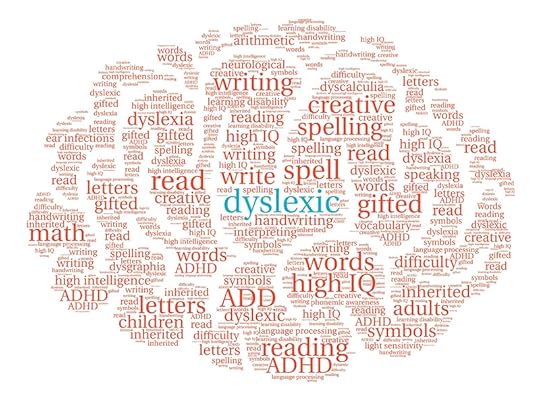
A Science Daily report on his study summed it up this way:
“Functional connectivity, unlike what the name might imply, is a dynamic description of how the brain is virtually wired from moment to moment. Don’t think in terms of the physical wires used in a network, but instead of how those wires are used throughout the day. When you’re working, your laptop is sending a document to your printer. Later in the day, your laptop might be streaming a movie to your television. How those wires are used depends on whether you’re working or relaxing. Functional connectivity changes according to the immediate task.
“The brain dynamically rewires itself according to the task all the time. Imagine reading a list of restaurant specials while standing only a few steps away from the menu board nailed to the wall. The visual cortex is working whenever you’re looking at something, but because you’re reading, the visual cortex works with, or is wired to, at least for the moment, the auditory cortex.
“Pointing to one of the items on the board, you accidentally knock it from the wall. When you reach out to catch it, your brain wiring changes. You’re no longer reading, but trying to catch a falling object, and your visual cortex now works with the pre-motor cortex to guide your hand.
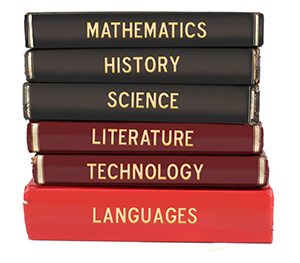
“Different tasks, different wiring; or, as McNorgan explains, different functional networks.
“In the two data sets McNorgan used, participants were engaged in different tasks: language and math. Yet in each case, the connectivity fingerprint was the same, and he was able to identify dyslexia with 94% accuracy whether testing against the reading group or the math group.”
These fascinating conclusions will be the subject of further study. What other domains of brain function are also co-wired to reading ability? In any case, the takeaway is clear: the case for early literacy diagnostics and intervention is even stronger than it was before. McNorgan sums it up this way, “These results show that the way our brain is wired for reading is actually influencing how the brain functions for math,” he said. “That says your reading skill is going to affect how you tackle problems in other domains.”
Thanks for reading about how reading shapes the brain. For a thorough discussion of dyslexia, you may enjoy the second edition of my award-winning book Raising a Child with Dyslexia: What Every Parent Needs to Know, available in softcover, hardcover, eBook, and audio. In addition to facts on testing and accommodation, my book gives you the tools to provide the social and emotional support children with dyslexia require. The second edition has the same great content as the first edition but now contains a very helpful bibliography and index and an exciting new cover.

And to learn more about how every student best learns to read, you may also enjoy Failing Students or Failing Schools? A Parent’s Guide to Reading Instruction and Intervention, by reading specialist and shortlisted World Literacy Award nominee Faith Borkowsky.

Cardboard Box Adventures picture books are great for shared reading and can help parents establish a strong preliteracy foundation for their children. Check out the CBA Catalog for a full list of award-winning picture books, chapter books, and resources for parents and educators. Visit my Amazon author page for more information.
References:
https://www.sciencedaily.com/releases/2021/03/210311142044.htm
https://www.frontiersin.org/articles/10.3389/fncom.2021.590093/full
The post How Reading Shapes the Brain appeared first on Author Don Winn's Blog.
May 3, 2022
Adult Dyslexia and Reading
Adult Dyslexia and Reading
You can listen to this blog.In both the fields of research and education there is a tremendous focus on diagnosing dyslexia in children and developing reading remediation programs to help them learn to read. This is very important. By helping children with early diagnosis, they can be helped to learn to read effectively. Through proper academic and social and emotional support, these children can avoid some of the trauma that the undiagnosed dyslexic learner tends to experience. But what about adult dyslexics, especially those who never had much help when they were in school? We hear very little about adult dyslexia and reading. Is it too late to help these learners?
If you’re a parent or educator who cares about struggling readers and you’ve never heard of Dr. Guinevere Eden, that’s about to change. As a full professor at Georgetown University and the Director for the Study of Learning, Dr. Eden has made a career of studying how the dyslexic brain learns to read. Her work is incredibly comprehensive; she not only focuses on developing advanced diagnostics of reading challenges, but also on discovering techniques that work best for remediation.
In the diagnostic arena, Dr. Eden’s brain imaging technology has allowed the previously invisible diagnosis of dyslexia—which can seem mysterious and inexplicable—into something very real and visible. And unlike many specialists who work with dyslexia, she doesn’t just offer science-based criteria for reading instruction for children. She also works with adult dyslexics who did not have the benefit of a supportive learning environment while growing up. A specific one of Dr. Eden’s studies of adults with dyslexia first brought her work to my attention, but more on that later.

It’s important to note that the fMRI brain scan technology Dr. Eden uses isn’t primarily focused on making individual diagnoses of dyslexia. Instead, she focuses on the statistical power of group studies. This is a key differentiation, because no two dyslexics are exactly alike, even within the same family. Why can dyslexia manifest so differently in different individuals and to such varying degrees?
While searching for the answers to that question, Dr. Eden focuses on what we can learn from both the similarities and the individual differences of each person’s dyslexia experience.
For example:
Why are so many different areas of the brain involved in dyslexia?How does the brain in people with dyslexia differ in terms of anatomy, or differ in the functions of each region, and how does this network of structures work together?What brain differences which later manifest as dyslexia can be seen from birth?Why do some, but not all, dyslexics also struggle with math?Why are the highest percentage of diagnosed cases of ADHD also dyslexic?How are the motor skills of the eye involved with learning to read well?Why do some dyslexics respond better than others to remediation?In readers who have received remediation, what visible brain changes have occurred when the brain is viewed via consecutive fMRIs?Are those brain changes compensatory?Are differences in motor skills and visual task acuity a part of dyslexia, even though they do not cause the reading difficulty, or are they the consequence of not learning to read?Why do the brains of female dyslexics differ from female non-dyslexics in ways that don’t mirror the distinctions seen in male dyslexic versus male non-dyslexic brains?Dr. Eden and her team continue to search for the answers to these questions. They focus on children, it’s true, but also on adult dyslexia and reading.
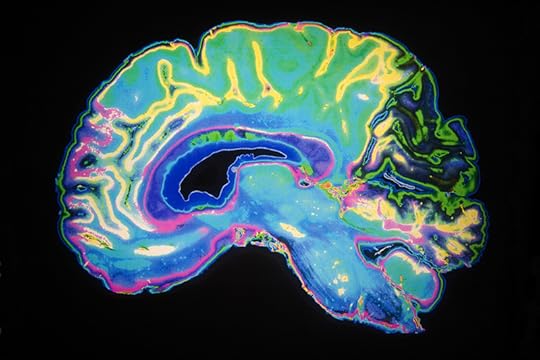
And that study by Dr. Eden that originally piqued my interest? This study showed that at any age—even as an adult—intensive, explicit phonological instruction offered remarkable results in reading improvement after only eight weeks! Participants in the studies showed strong improvements in both phonological awareness as well as reading accuracy skills. Not only that, but the fMRI scans of their brains showed a marked difference in both levels and locations of brain activity between the before and after scans. Imagine that! With only two months of specialized reading instruction, dyslexic adults can effectively retrain their brains to help compensate for some reading deficiencies caused by dyslexia.
This is amazing to me. As a dyslexia advocate, I recognize the extreme importance of early diagnosis of dyslexia in children so that they can get access to remediation as soon as possible. We always hear so much about helping children improve reading skills through remediation. But we hear very little about helping adult dyslexic learners through remediation. As an adult dyslexic, this had a huge impact on me. In time, we may see the development of specialized programs that focus on helping adult dyslexic learners improve their reading.
One of the study’s participants had never read a book before in her life. Following the study, she read before work every day, setting her alarm clock so she could wake up early to do so. The takeaway? It’s never too late to improve your reading skills—and your life! Thank you, thank you, thank you, Dr. Eden!
Thank you for reading about adult dyslexia and reading.

For a thorough discussion of dyslexia, you may enjoy the second edition of my award-winning book Raising a Child with Dyslexia: What Every Parent Needs to Know, available in softcover, hardcover, eBook, and audio. In addition to facts on testing and accommodation, my book gives you the tools to provide the social and emotional support children with dyslexia require. The second edition has the same great content as the first edition but now contains a very helpful bibliography and index and an exciting new cover.

And to learn more about how every student best learns to read, you may also enjoy Failing Students or Failing Schools? A Parent’s Guide to Reading Instruction and Intervention, by reading specialist and shortlisted World Literacy Award nominee Faith Borkowsky.
Cardboard Box Adventures picture books are great for shared reading and can help parents establish a strong preliteracy foundation for their children. Check out the CBA Catalog for a full list of award-winning picture books, chapter books, and resources for parents and educators. Visit my Amazon author page for more information.
References:
https://gufaculty360.georgetown.edu/s/contact/00336000014RdJHAA0/guinevere-eden
https://www.sciencedaily.com/releases/2004/10/041030212457.htm
https://pubmed.ncbi.nlm.nih.gov/30721792/
https://pubmed.ncbi.nlm.nih.gov/27566261/
The post Adult Dyslexia and Reading appeared first on Author Don Winn's Blog.
April 20, 2022
Dyslexia Is Like Black-and-White Photography
Dyslexia Is Like Black-and-White Photography
You can listen to this blog.Lately, I’ve been thinking a lot about all the ways a person can live with a limitation. Sometimes limitations are imposed upon us by others—a curfew for a teen, HOA standards, social unrest, or work deadlines, to name a few. At other times, limitations come from within, like gluten intolerance, nearsightedness, or a bad back. And in the case of dyslexia, most would agree that, while it presents strengths, it is also a limitation, even if we’re only taking into account the amount of extra time a dyslexic learner needs to accomplish tasks.

But even though a limitation can be frustrating sometimes, a limitation can create beauty as well. And here’s where we get to the link between dyslexia and black-and-white photography. Although color film or digital cameras can render colors impeccably in a scene or portrait, some notable artists choose to limit themselves by shooting only in black-and-white. By eliminating the distraction of color, a landscape or portrait can be distilled down to its very essence: light and shadow. The purity of the beauty of form and the chase after light is never more clear, more palpable, than in a black-and-white photo.
When you think of black-and-white photography, many of you might immediately think of the work of photographer Ansel Adams (1902-1984). Link: Ansel Adams Biography
Mr. Adams earned his fame and distinction by limiting his work exclusively to the black-and-white medium. Although color photography became widely available in 1935 with the invention of Kodachrome film, Mr. Adams had found his voice with which to communicate with the world, and he never wavered. He continued to choose this self-imposed limitation on his creative voice, and his work stands amongst the most seminal in photography.
What I didn’t know was that he had learning challenges including—most likely—dyslexia. In a PBS show about his life, Adams had this to say: “In school…each day was a severe test for me, sitting in a dreadful classroom while the sun and fog played outside. Most of the information received meant absolutely nothing to me. For example, I was chastised for not being able to remember what states border Nebraska and what are the states of the Gulf Coast. It was simply a matter of memorizing the names, nothing about the process of memorizing or any reason to memorize. Education without either meaning or excitement is impossible. I longed for the outdoors, leaving only a small part of my conscious self to pay attention to schoolwork.”

He was asked to leave numerous private and public schools because of hyperactivity and his performance issues. Eventually, he achieved an eighth-grade diploma through being home-schooled by his father and aunt. I find this of particular interest. His father, a wealthy San Francisco socialite, could have shown disapproval or even rejected his son for not living up to social expectations. Instead, he observed that his son had a deep connection with nature and nurtured an environment that would allow his son to flourish. When just a lad, the family made their first trip to Yosemite, and young Adams had a Kodak Brownie in hand. The rest, as they say, is history.
My observation is that his limitations with focus and learning in “traditional ways” allowed him to “see” the world in ways no one before or since has captured in exactly the same way. His grasp of the power of light and shadow to reveal the true essence of a scene or subject spoke, not of limitations as a hindrance, but as a strength.

Today’s struggling students need more opportunities to allow their voices and their visions to show the beauty that is already present within them. When children have the inclination to express themselves through art, dance, music, cooking, building things, or whatever area appeals to them most, they will flourish. And the more you and I focus on recognizing these gifts and encouraging them, the happier and more well-rounded a child can be.
Thank you for reading Dyslexia Is Like Black-and-White Photography. If you would like to read other dyslexia-related blogs, please see my dyslexia article archives page.
To learn how creativity is the path to maximizing a dyslexic child’s potential, don’t miss my upcoming webinar: “Creativity: A Doorway to Finding a Dyslexic Child’s Potential” on Tuesday, April 26th at 7:00 pm Central Time. Register today at Eventbrite. Registration requires a small donation of your choosing, starting at a $1.00 minimum donation.
For a thorough discussion of dyslexia, you may enjoy the second edition of my award-winning book Raising a Child with Dyslexia: What Every Parent Needs to Know, available in softcover, hardcover, eBook, and audio. In addition to facts on testing and accommodation, my book gives you the tools to provide the social and emotional support children with dyslexia require. The second edition has the same great content as the first edition but now contains a very helpful bibliography and index and an exciting new cover.

And to learn more about how every student best learns to read, you may also enjoy Failing Students or Failing Schools? A Parent’s Guide to Reading Instruction and Intervention, by reading specialist and shortlisted World Literacy Award nominee Faith Borkowsky.

Cardboard Box Adventures picture books are great for shared reading and can help parents establish a strong preliteracy foundation for their children. Check out the CBA Catalog for a full list of award-winning picture books, chapter books, and resources for parents and educators. Visit my Amazon author page for more information.
The post Dyslexia Is Like Black-and-White Photography appeared first on Author Don Winn's Blog.
April 14, 2022
Nurturing Creativity in Dyslexic Learners
Webinar: Nurturing Creativity in Dyslexic Learners
Description: Every child has something they love to do. Nurturing creativity in dyslexic learners plays an important part in their academic achievement. As a parent or educator, how can you discover and then amplify children’s innate abilities to help them realize their potential? In this webinar you will learn the following:
How a child’s innate abilities are a doorway through which they can reach their academic potentialHow to recognize vertical and horizontal identity and understand how it can help parents embrace their child’s uniqueness and creativityHow to identify a child’s unique giftsHow to embrace and foster a child’s unique gifts to help them reach their potentialAnd much more…This information is presented by award-winning author and dyslexia advocate Don M. Winn, so don’t miss this exciting opportunity to find new ways to engage and nurture your child’s sense of creativity while helping them academically.
Availability
Initial webinar: Tuesday, April 26th at 7:00 pm CDT
Encore presentation: Saturday, April 30, 2022, at 1:00 pm CDT
Register today at Eventbrite. Registration requires a small donation of your choosing, starting at a $1.00 minimum donation.
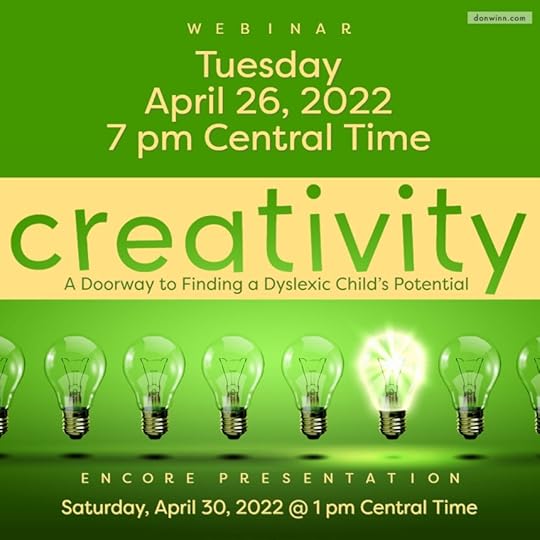

For more information about dyslexia, see Don M. Winn’s Dyslexia Article Archives page.
For a thorough discussion of dyslexia, you may enjoy the second edition of my award-winning book Raising a Child with Dyslexia: What Every Parent Needs to Know, available in softcover, hardcover, eBook, and audio. In addition to facts on testing and accommodation, my book gives you the tools to provide the social and emotional support children with dyslexia require. The second edition has the same great content as the first edition but now contains a very helpful bibliography and index and an exciting new cover.
Cardboard Box Adventures picture books are great for shared reading and can help parents establish a strong preliteracy foundation for their children. Check out the CBA Catalog for a full list of award-winning picture books, chapter books, and resources for parents and educators. Visit my Amazon author page for more information.
The post Nurturing Creativity in Dyslexic Learners appeared first on Author Don Winn's Blog.
April 5, 2022
Early Signs of Reading Difficulties
Early Signs of Reading Difficulties: Interview with reading specialist Faith Borkowsky
You can listen to this blog.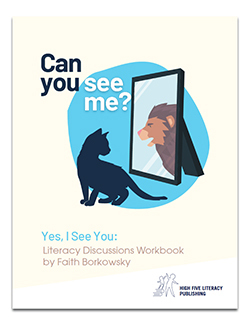
One of the most dynamic, energetic people I know is fellow author Faith Borkowsky. Faith has decades of training and experience as a specialist in reading instruction and has helped countless students overcome obstacles to reach their potential. So when I noticed that she had written a free workbook for people who care about struggling readers, I had to find out more. I reached out with questions, and the resulting interview follows. You will learn about possible indicators to be on the lookout for that may predict that a child will struggle to read later in life–early signs of reading difficulties–and also the effect that struggling to read has on a child’s mental health. Enjoy!
Don: What prompted you to write your new workbook, Can You See Me? Yes, I See You?
Faith: It is designed to stimulate discussion about what each of us, regardless of background, education, or socioeconomic status, can do to change a child’s life. The workbook follows the evolution of a child falling through the cracks in plain sight. The downward spiral illustrated in the workbook is an extreme case, but it is meant to shine a spotlight on the ever-growing emotional distress of children who struggle to learn to read and the societal consequences of missing the signals at every stage.
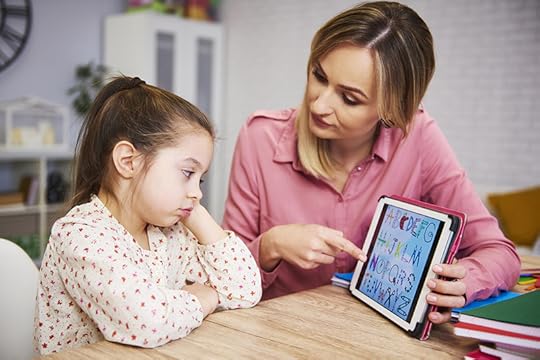
Don: What are language milestones, why might they be early signs of reading difficulties, and why should parents watch for them?
Faith: Children develop the majority of their speech and language skills in the first three years of life. If a child is not reaching language milestones, speech and language intervention services should be started as soon as possible during this critical period. Speech and language difficulties and delays impact reading development, and parents should be aware if their children are at risk for later reading impairment. Here is a link for more information: https://www.asha.org/public/speech/development/chart/
Don: I see several chapters in the workbook that point to sensory processing issues that a child might have. Why is it important for parents to see these and understand them? How might they be early signs of reading difficulties?
Faith: Sensory challenges can be indicative of other problems and should be part of the conversation when looking at a child’s development. It is not unusual for children to have overlapping areas of concern. Sometimes the education community describes this as “co-existing,” “co-morbid,” or “co-occurring” disorders. I choose to look at such factors as “red flags” of possible reading problems. To be clear, sensory issues do not cause reading problems, but they can be symptomatic of underlying problems that seem to make processing sounds more difficult. Since reading requires multiple areas of the brain to work together, there is a high degree of overlapping conditions.
Don: You point out the link between a child’s struggles to communicate and the onset of self-loathing. Would you share an example of a student you have worked with?
Faith: Can You See Me? represents many children I have taught to read over the years. Their difficulties might not all look the same, but most children with profound reading problems have a history of speech and language delays or articulation difficulties. Many of them have poor self-esteem and either misbehave or become withdrawn. It can happen as early as kindergarten or as late as middle school. Children respond to their environment, so adults must have patience and understanding. For instance, it’s not a good idea to complete a sentence for a child or rush him or her to answer a question. This can make a child feel stressed and uncomfortable.

Don: Why are motor skills important to address, what might point to a child’s having issues with motor skills, and how might difficulties with motor skills potentially be early signs of reading difficulties?
Faith: Just like sensory issues, fine-motor difficulties are often present in children with reading difficulties; however, correlation doesn’t mean causation. Although one may observe this relationship, I want to emphasize the importance of not wasting precious time on generalized movement activities in the hope of improving reading and writing. Handwriting must be taught explicitly and thoroughly, just like reading should be taught. Writing properly-formed letters requires visual motor integration, and it is likely to see kids struggling, possibly because of a slower processing link. Cognitive deficits as potential predictors of dyslexia and dysgraphia show a high similarity. Preschool and kindergarten teachers should be trained to identify such areas of concern and not take them lightly.
Don: What is the “mixed method” approach to reading instruction, and why is it so confusing to a struggling reader?
Faith: Mixed methods to decode unfamiliar words is traditionally what reading instruction looked like in school, such as using context cues and pictures. Even worse, many kids are still taught to memorize a list of “sight” words without teaching a connection to letters and sounds. Any strategy that encourages kids to guess or read around a word instead of left to right, all through the word, makes it more difficult for children to learn to read, especially those kids who struggle. Instruction should focus attention on building the foundation.

Don: You quote a shocking statistic from the Journal of Learning Disabilities. What is the link between unremediated learning challenges and mental health?
Faith: I wrote a blog a while ago called “Dying to Read and Write” where I wrote about how some instances of suicide can be traced to the inability of learning to read and write. Students with learning disabilities like dyslexia have a three times higher risk of attempting suicide, according to the 2006 Journal of Learning Disabilities. We barely talk about the role illiteracy plays in creating anxiety and depression. Your book, Don, is one of the few that addresses this need. So many parents of my students are faced with finding therapists to deal with the emotional baggage that goes hand in hand with learning difficulties.
Don: How can parents benefit fully from using this free workbook?
Faith: The Can You See Me? workbook can be downloaded for free from my website at www.ifonlybooks.com. They can click on the tab labeled “Free Resources” and download the .pdf to use with their child’s school district or community organization. It is a tool for raising awareness, and, more importantly, setting the wheels in motion to build a community action plan. At the end of the workbook, there is a timeline for all participants to commit to doing something that is within their power to make a difference. Accountability is extremely important in terms of seeing real progress.
Don: Is there anything else you would like to add?
Faith: Under the “Free Resources” tab, parents will also see the If Only Book Discussion Guide for those who would like to take the next step and organize a book club discussion of my book series, “If Only I Would Have Known…” The discussion guide provides questions to help facilitate conversations about early literacy and language development, literacy instruction, dyslexia, and intervention for struggling readers. They can take a moment to view the video for a demo of a book club in action.

Thanks so much, Faith, for sharing these points with my readers. I know that this free workbook will help so many families and educators detect early signs of reading difficulties and connect in a meaningful way with the struggling readers in their life. And please: help us spread the word! Let family and friends know about this incredible free resource. This book presents an opportunity to, as it were, sit next to an expert and learn from her decades of experience. Every child needs to learn to read well, and the issues and techniques in this book will make the difference.
To learn more about how every student best learns to read, you may enjoy Failing Students or Failing Schools? A Parent’s Guide to Reading Instruction and Intervention, by reading specialist and shortlisted World Literacy Award Nominee Faith Borkowsky.
And for a thorough discussion of dyslexia, you may also enjoy the second edition of my award-winning book Raising a Child with Dyslexia: What Every Parent Needs to Know, available in softcover, hardcover, eBook, and audio. In addition to facts on testing and accommodation, my book gives you the tools to provide the social and emotional support children with dyslexia require. The second edition has the same great content as the first edition but now contains a very helpful bibliography and index and an exciting new cover.

Cardboard Box Adventures picture books are great for shared reading and can help parents establish a strong preliteracy foundation for their children. Check out the CBA Catalog for a full list of award-winning picture books, chapter books, and resources for parents and educators. Visit my Amazon author page for more information.
The post Early Signs of Reading Difficulties appeared first on Author Don Winn's Blog.
March 22, 2022
Reading Teacher Challenge: Dyslexia
Reading Teacher Challenge: Dyslexia 2022 ALTA Summit Part 2
You can listen to this blog.Welcome back to the continued discussion as reading specialists responded to my question, “What are your greatest challenges when working with children with dyslexia?”
Reading Teacher Challenge 1: “Dealing with the urgency of the work. I put a lot of pressure on myself to help them as much as I can as quickly as I can because I was this child.”
Suggestions: This one really touched my heart. And you’re right, there is a legitimate time crunch. There’s a small window of time during which a child learns to read, and then for the rest of their life, they read to learn. So often, we don’t detect these kids until that optimal window is already past. But there is also always enough time for the things that matter. When caring educators allow themselves to take a breath, you recognize that what’s most important is showing personal interest, patience, and compassion. Now the student has a safe, nurturing environment, and in that relaxed space, you give the child their fullest opportunity to recover and bloom as readers and learners.
The most direct route to effective remediation is to take the time on the front end to evaluate different approaches, discern the best fit for the child, and adjust as needed based on results.

Reading Teacher Challenge 2: “Accommodations in the classroom without an IEP.”
Suggestions: Request a parent-teacher conference, at which you can discuss the child’s strengths and areas that need more support. Most accommodations fall under the umbrella of presenting information differently, testing differently, and the ways the student practices new skills. At the conference, discuss 2–4 accommodations to implement, and set a follow-up meeting for the next month to evaluate the child’s response. It’s important for the parent to understand that not all students require the same accommodations; rather, this is a partnership in which parents and teachers collaborate and provide input so the child has their best chance of success.
Reading Teacher Challenge 3: “Working with junior high students that have dyslexia, they struggle with doing (completing) their work.”
Suggestions: Often, the greatest barriers to success for students of this age are a lack of understanding of what dyslexia is and unacknowledged trauma. In order to embrace their own dyslexic experience, they need to be educated. What are the different manifestations of dyslexia, dysgraphia, dyscalculia, dysphonia, and dyspraxia? Which aspects affect them? How late were they diagnosed? Without understanding these things, all they will know is that school is hard and they don’t like it.
When parents and teachers help each student understand and accept their own reality, while at the same time acknowledging their trauma with compassion, it builds a foundation for learning. Once the student has accepted their reality, they can be helped to see ways each subject and lesson is an investment in their future, and therefore, worth their time and effort. Praising their efforts as they work through things goes a long way toward validating that they are doing something special and worthwhile.

Reading Teacher Challenge 4: “Students who reverse letters like b and d consistently.”
Suggestions: Use multisensory materials like trays of salt, sand, or confetti while teaching the alphabet. To engage multiple areas of the brain and aid memory, make sure the child says the letter name and sound while tracing the letter. For example, b says /b/ while tracing the letter—repeat multiple times.
Use visual and oral scripted auditory cues to cue correct letter formation. A common auditory script cue is to form the b as a “bat before a ball.” This will provide a cue that the stick is formed first while writing the letter. The d is cued as a “drumstick.”
Reading Teacher Challenge 5: “I work with older students from 6th grade–12th grade. Most are highly intelligent and have pre-formed coping in place. They can be somewhat resistant to the therapy. And they voice complaints to parents, teachers, friends…and so on.”
Suggestions: Focus on the positives. Older students can be so encouraged when they discover that these pre-formed coping skills are a manifestation of self-efficacy. Self-efficacy is defined as the belief in one’s ability to achieve goals and succeed. Even before they fully understood dyslexia or knew of its existence, their creative brain had already generated workarounds for their situation. Help them to see that they are not alone and that science-based learning techniques can offer even more effective, less stressful ways of addressing their dyslexia. It can be hard at first to change how they approach learning, homework, and other tasks, but in the long run, learning what works best from the collective experiences of all dyslexics and the scientists who specialize in studying dyslexia will help them build on what they have already begun. This, in turn, helps them see that they aren’t stuck where they’ve been but instead can continue to grow. A growth mindset combined with self-efficacy is life-changing.
Reading Teacher Challenge 6: “My challenges are with parents, teachers, and administrators. Explaining dyslexia can be a challenge.”
Suggestions: As hard as it is to believe, even in 2022, dyslexia is misunderstood. And that’s by school administrators and educators! A sizeable number of parents are in the dark about dyslexia and all its sibling conditions. Handouts of FAQs about dyslexia can be helpful, and you can refer people to my archive of blogs on all aspects of dyslexia. Additionally, I can recommend several documentaries that really help lay a foundation for understanding dyslexia, including:
The Big Picture: Rethinking DyslexiaInside Dyslexia: Seeing Through a Different LensRead Me DifferentlyEmbracing DyslexiaBeing You, A documentaryReading Teacher Challenge 7: “Getting them to the next step. They say all the sounds then blend the word together. Difficult to get them to the next step to just read the word as a whole.”
Suggestions: Kids who have difficulty blending phonemes (sounds) into words are lacking in phonemic awareness skills. Most kids show up on their first day of school without a foundation of phonemic awareness. Blending sounds also requires the child to hold the individual sounds in their mind as the word is created. This ability to hold sounds or syllables on a child’s “mental desktop” uses a student’s active working memory. Kids with dyslexia often have poor working memory skills.
A fantastic article with activities (and videos!) is found here: https://phonicshero.com/blending/
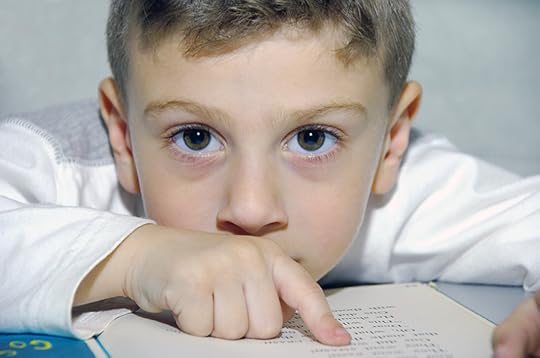
Reading Teacher Challenge 8: “Getting them to read grade-level material.”
Suggestions: The Yale Dyslexia experts have observed that it takes an average of 100 hours of one-on-one or small-group instruction to help young adults move ahead one grade level in their reading skills. For younger students, it can require even more of a time investment. Translation: it’s a long haul. Therefore, goals must be realistic and concrete. So much of the road to grade-level reading material is the daily practice of reading leveled material, books the student can read with little or no assistance. Parents can support the process by reading a chapter of a really engaging book with a great story with their child every day. By helping the student see that reading is fun and exciting, and that it makes their life better, they are helped to maintain forward momentum.
Reading Teacher Challenge 9: “My greatest challenge when working with children with dyslexia is convincing specific children in accepting progress over perfection.”
Suggestions: Overcoming perfectionism is a process. Stanford professor Carol Dweck documented that perfectionism (a fixed mindset) can be replaced by a growth mindset. How? Praise the child’s efforts, not the outcome. In Professor Dweck’s studies, students with a fixed mindset had no real way to handle learning difficulties, and so they were quick to give up or become defensive—either acting bored, acting out, blaming the teacher, or blaming the material to hide their fear of not looking smart. Students with a growth mindset understand that learning takes practice and realize that even geniuses have to work hard (and long) for their discoveries. https://www.penguinrandomhouse.com/books/44330/mindset-by-carol-s-dweck-phd/
And just for fun, share chapters of the book Mistakes That Worked. This book is a great way to reframe the belief that mistakes are bad and to be avoided. Instead, good things can happen when we aren’t afraid to fail at first!
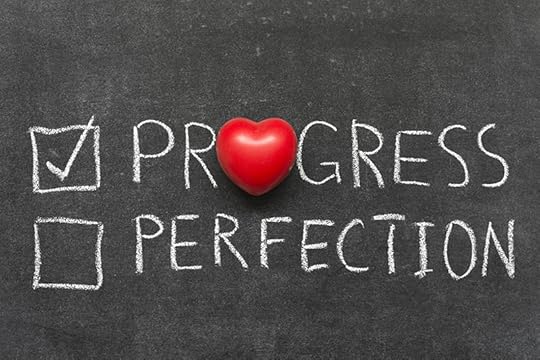
As you can see, the situations encountered by caring educators are varied and challenging. And here’s the thing: the more we can all share what has worked for ourselves and others, the better the conversations about helping dyslexics will be. And isn’t that what matters?

I’d love for readers to share their own challenging teaching situations they encounter when teaching reading so we can keep this conversation going. Feel free to reply to this blog—I’d love to hear from you!
For a thorough discussion of dyslexia, you may enjoy the second edition of my award-winning book Raising a Child with Dyslexia: What Every Parent Needs to Know, available in softcover, hardcover, eBook, and audio. In addition to facts on testing and accommodation, my book gives you the tools to provide the social and emotional support children with dyslexia require. The second edition has the same great content as the first edition but now contains a very helpful bibliography and index and an exciting new cover.

And to learn more about how every student best learns to read, you may also enjoy Failing Students or Failing Schools? A Parent’s Guide to Reading Instruction and Intervention, by reading specialist and shortlisted World Literacy Award nominee Faith Borkowsky.
Cardboard Box Adventures picture books are great for shared reading and can help parents establish a strong preliteracy foundation for their children. Check out the CBA Catalog for a full list of award-winning picture books, chapter books, and resources for parents and educators. Visit my Amazon author page for more information.
The post Reading Teacher Challenge: Dyslexia appeared first on Author Don Winn's Blog.
March 8, 2022
Challenging Teaching Situation: Teachers in the Trenches, Reading and Dyslexia
Challenging Teaching Situation: Teachers in the Trenches, Reading and Dyslexia, 2022 ALTA Summit Part 1
I love when I get to interact with teachers—they’re the folks with boots-on-the-ground experience in education. Being an educator is one of the toughest, least well-compensated careers, and it calls for tremendous passion and persistence. This is even more true for those who choose to specialize in reading instruction, and I am always delighted to get to know these caring people.
I was recently honored to speak at the 2022 Academic Language Therapy Association (ALTA) Summit Meeting. ALTA is the professional credentialing organization for educators who have qualified as multisensory academic language therapists and practitioners using evidence-based reading instruction methods. I asked the attendees this question:
What are your greatest challenges when working with children with dyslexia?
When the attendees reached out to me with their responses and questions of their own, I paid attention. This blog and the one to follow share the challenging situations (and the suggestions I provided) faced by anyone who works with struggling readers.
Challenging Teaching Situation 1: “Being able to differentiate in the classroom with children who are working on different levels. I teach in a school for the LD learner, so we already have many supports in place (audio, Learning Ally, laptops for all, Executive Function tools, etc.).”
Suggestions: Flexibility and options. Some students need a quiet corner to be able to focus, others work better in groups. Some educators have found that allowing the students to come up with their own projects (as long as the lesson requirements are fully covered) helps keep students of different levels engaged. Grouping students based on their tier of activity helps as well.

Challenging Teaching Situation 2: “Trying to explain to parents it is not an overnight ‘fix’ but rather a life-long practice of utilizing the tools that are given to the students and having the students understand their learning profiles.”
Suggestions: Parents need gentle encouragement to cope with their emotional response to the information that their child has a lifelong issue. Parents need to hear that while it is true their child has this lifelong issue, there is no reason to lower their expectations. Their child can still develop their full potential, but it will require consistent effort on the part of everyone on the team: the student, parents, and educators.
Challenging Teaching Situation 3: “Struggling with spelling issues.”
Suggestions: Using singing to spell, based on songs with a beat that matches the number of letters of the word. Music engages a different part of the brain and helps the child have an additional pathway of memory association for their spelling words.
Link: https://organizedclassroom.com/singing-to-spelling-idea/
Challenging Teaching Situation 4: “My greatest challenge is to keep the students focused during the lesson.”
Suggestions: I have heard great things from teachers who provide interest centers. Almost any class material can be presented via multiple scenarios that will be relatable to students with different cultures, home situations, and interests. Also, think in terms of incremental gains: Rome, as they say, wasn’t built in a day, and neither is a focused student. Begin with the child’s natural focus time, even if it is five minutes, and gradually increase the time the child stays on task, with lots of celebration for each added minute of focus.
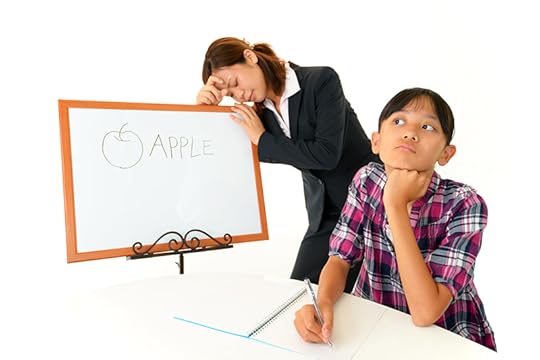
Challenging Teaching Situation 5: “Understanding the lack of reading fluency in a remediated student. Is there a connection with ADHD or are there some students who don’t read fluently?”
Suggestions: In my experience, students who lack fluency after remediation may not have had a remediation style that speaks to the way their brain processes and retrieves information. (And this is not your fault!)
Not all students who struggle to read have focus issues. But even for those who do, all students can become fluent when a multisensory approach to teaching reading is utilized. Often, school-board-approved remediation focuses on sight words or other long-standing techniques that don’t incorporate science-based information on how the brain actually learns to read and develop fluency.
I’ve had the privilege to meet and work with many reading specialists, and their consensus is that even in students with late diagnoses, the most effective remediation to build fluency and comprehension is the Orton-Gillingham approach or the Wilson Method.
Challenging Teaching Situation 6: “Virtual learning due to difficulty to use hands-on materials and attention.”
Suggestions: Attention and focus issues are best addressed by making the material relatable. What is the student actually interested in? What are their passions, their dreams? Why are those topics or dreams important to them?
What items do they have at home that can be used to facilitate a learning experience? By giving students the opportunity to share things important to them personally, and then connecting those dreams to learning opportunities that will help them reach those dreams, virtual learning becomes a priority.

Challenging Teaching Situation 7: “Students with low working memory.”
Suggestions: For the kid with poor working memory, it’s so important to celebrate every effort, every victory, and every success. Every effort is a success, since giving up always seems easier. Praising the child’s efforts rather than focusing exclusively on the completion of tasks builds rapport, respect, and encourages the child to keep showing up for their hard work every day. Patience and creativity on your part keep the child engaged and prove how much you are invested in helping them succeed.
When a student has low working memory or poor phonological awareness, no matter how hard you work or how much you care for that student, if you don’t meet them where they are academically, you will both be unfulfilled. Here’s the point: sometimes we have to deal with our own disappointment or sadness about a student’s struggles to perform to reach a place of acceptance of where they are. Only then can we offer them what will fit their capabilities at this moment.
Challenging Teaching Situation 8: “Helping parents understand their child’s needs and then teaching them how to help their child unlock his or her potential through patience and support.”
Suggestions: Just like a child who develops Type 1 diabetes, a child with dyslexia or its sibling conditions requires a daily routine, emotional support, and an educated parent who is involved and knows the symptoms to watch for in their child that indicate the need for attention. At the most basic level, a dyslexic student has two primary needs: (1) extra time in which to complete tasks, and (2) social and emotional support to deal with the feelings that are a big part of facing the daily slog of dyslexia. For practical suggestions on what social and emotional support looks like, including sample conversations, see my book Raising a Child with Dyslexia, What Every Parent Needs to Know.
If the parent is reluctant or unable to provide needed support, it’s important to find a mentor in the child’s extended family or community to serve as a proxy for this important role. Ask the parent for a recommendation of a trusted friend or relative. Kids need ongoing support and encouragement beyond what teachers can give them in the classroom.

Challenging Teaching Situation 9: “So many struggle with attention as well. It is a struggle to help kids with comorbid conditions. What are some strategies that may help when going through a lesson?”
Suggestions: By starting with topics that engage the student the most, that student begins to discover the joy of being a learner. Just like starting a baby on soft food, we begin with what is sweetest: applesauce, bananas, and carrots—not turnips and brussels sprouts. Maybe students have a story they’d love to tell, an experience that they long for, or a topic that lights up their brain. Start with those, so the students will begin to see what great learners and readers they already are. When students are helped to change their identity so that they see themselves as learners, they change their approach to life and the classroom.
Challenging Teaching Situation 10: “Working in a district that uses a good curriculum and has a good program—not just something to check the box and say we service our dyslexics.”
Suggestions: Amen to that. You are not the first educator who has observed that what is being “sold” as a good program in their district does not include evidence-based learning. My friend, fellow author and reading specialist Faith Borkowsky, writes about her observations and frustrations on this subject here in her blog, Soundbites and Slogans: One District’s New Literacy Plan and A Reality Check on the Intersection of Dyslexia and the Reading Workshop

There is more to come! Don’t miss the next installment of dialog generated by the 2022 ALTA Summit and its incredible, caring educators!
For a thorough discussion of dyslexia, you may enjoy the second edition of my award-winning book Raising a Child with Dyslexia: What Every Parent Needs to Know, available in softcover, hardcover, eBook, and audio. In addition to facts on testing and accommodation, my book gives you the tools to provide the social and emotional support children with dyslexia require. The second edition has the same great content as the first edition but now contains a very helpful bibliography and index and an exciting new cover.

And to learn more about how every student best learns to read, you may also enjoy Failing Students or Failing Schools? A Parent’s Guide to Reading Instruction and Intervention, by reading specialist and shortlisted World Literacy Award Nominee Faith Borkowsky.
Cardboard Box Adventures picture books are great for shared reading and can help parents establish a strong preliteracy foundation for their children. Check out the CBA Catalog for a full list of award-winning picture books, chapter books, and resources for parents and educators. Visit my Amazon author page for more information.
The post Challenging Teaching Situation: Teachers in the Trenches, Reading and Dyslexia appeared first on Author Don Winn's Blog.
February 22, 2022
Seeing the World Differently
A middle-aged friend of mine recently got his first dog. That statement alone is enough to make the story interesting; who of us hasn’t had a dog, at least during childhood? Maybe that’s just me, perhaps many people have never owned a dog. In any event, my friend’s adventures as a dog owner have been the subject of numerous text messages, complete with pictures, and so I’ve been able to have a vicarious dog experience. It’s been very enjoyable and has brought many a smile to my face. Oddly enough, it’s helped me begin seeing the world differently.

Why? One thing my friend said really struck a chord with me. He said, “The dog looks at everything. And the dog has to stop and smell everything. It’s as if everything in the neighborhood is new and exciting. He’s making me slow down and really notice my surroundings.”
It got me thinking about how often I look but don’t really see or experience the things around me. How often do I slow down and look at creatures and plants in nature around me, notice their texture and color, their size and shape? Not often enough. No, instead, I trudge from one end of the house to another, focused on some task. At other times—okay, most of the time—I’m dithering over my own inner narrative, oblivious to the play of light and shadow throughout the day as the sun makes its way across the sky. Or I drive to and from errands without noticing the exposed skeletons of trees, the sound of the wind, the blue-gray light of winter skies.

I’ve noticed these tendencies in myself even more often lately, as the pandemic grinds ever onward. So that’s why seeing the pictures of my friend’s dog and being able to share in the effect it’s having on him is such a lift to my spirits. It’s been a great reminder that every moment is special, and that beauty and joy surround us. Sometimes it takes the love and curiosity of a great dog to get us out of our headspace, start seeing the world differently, and get back into the life that is going on all around us.
As my friend revels in the adventures of his new pup, every dandelion is a magical game. The first romp through the snow brings delight, and even snuffling around the lawn searching for grasshoppers is great fun.

And because of what he’s sharing with me, I am making more time to look out the window in my office. The squirrels are busy preparing for winter. I smile when I see the neighborhood’s stray tomcat surveying his domain. I note the rays of the sun lighting different parts of the home through the day, and the way its rays pierce the branches of our various houseplants and turn them, just for a moment, into living stained glass.
Life isn’t perfect, but when I really pay attention to what surrounds me, it is very, very good.
Cardboard Box Adventures picture books are great for shared reading and can help parents establish a strong preliteracy foundation for their children. Check out the CBA Catalog for a full list of award-winning picture books, chapter books, and resources for parents and educators. Visit my Amazon author page for more information.
The post Seeing the World Differently appeared first on Author Don Winn's Blog.
February 8, 2022
How Childhood Beliefs Are Formed and Why They Matter
How Childhood Beliefs Are Formed and Why They Matter
You can listen to this blog.In my last blog, I discussed ways a parent can begin to untangle their child’s behaviors by digging deeper into any mistaken beliefs the child has created about themselves. Along those lines, it is important to understand how childhood beliefs are formed and why they matter.
In addition, it is helpful to understand the way the brain creates beliefs and thoughts. This knowledge will better equip parents to understand how to help kids rethink any mistaken conclusions they have made about themselves that may cause them emotional pain.
In human psychology, there is a term that describes how all our beliefs are formed. That term is meaning-making. Meaning-making is defined as the process by which all people (even children) interpret, understand, or make sense of life events, themselves, and relationships.
In other words, from a very tender age, we are all seeking to understand what things mean.
My classmates are making fun of me, what does that mean?I can’t understand what the teacher is saying, but it seems easy for others, what does that mean?Grownups yell at me, what does that mean?My parents are mad when I bring home my report card, what does that mean?Someone looked at me funny, what does that mean?When I think about having to read, my stomach hurts and I want to hide, what does that mean?I’ve tried everything to do this (whatever “this” is), and nothing is working, what does that mean?My classmates who are really smart (have more money, are better looking, etc.) have more friends, what does that mean?I asked for help and no one listened, what does that mean?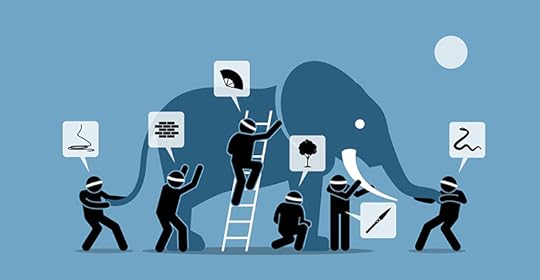
Here’s the thing about meaning-making: the process hinges largely upon connecting something we are experiencing now with something we have previously experienced. If it feels the same, we react the same. So, when children experience something for the first time, especially if it produces feelings of trauma, disappointment, fear, or hopelessness, the meanings ascribed to those events become the foundation for what those children expect to deserve for the rest of their lives.
Since children have nothing with which to compare a first-time event, the meanings that they make without the benefit of a mature perspective can be profoundly impactful. They may begin to believe statements like the following: I’m not good enough. I’m not worthy. I’m too much for my parents and teachers. I need more than other people, and that means I’m broken. I’ll never feel safe or loved. I don’t belong. I don’t deserve to live.
As a child makes meanings such as these out of the events and feelings in their lives, they are forming core beliefs about themselves. Often, changes in a child’s behavior can reveal that a child has made a meaning out of an experience that has resulted in a negative core belief about themselves. It is vital for the caring adults in a child’s life to notice and address the emotions and behaviors a child exhibits. Otherwise, the suffering in that child’s life will last until they begin to unpack those beliefs themselves later in life, usually at great financial and emotional expense.

As caring adults, we can gently support our young people by approaching their beliefs, conclusions, and the meanings they have made with the curious question, “What if that event means something completely different?” Offer some alternative meanings. Then observe what happens to the feelings and anxieties of the child. If the child has concluded that the situation is hopeless, they can be supported emotionally while the two of you explore options. All the while, it is important to continue reassuring the child that just because solutions haven’t immediately presented themselves, that doesn’t mean that there aren’t any solutions. There’s the power of meaning-making in action, once again.
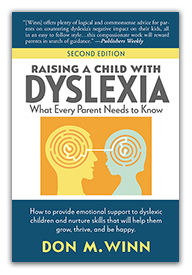
What’s the takeaway here? The behavioral and academic challenges young people face are a doorway to walk through in exploration of the meanings they have made from their experiences. By unpacking those conclusions and presenting alternative options about what those events mean from a more experienced perspective, you help the child avoid a lifetime of self-fulfilling negative expectations for themselves. Expectation affects the outcome, but only 100% of the time. By making sure the social and emotional aspects of child development are lovingly cared for, the next generation will be poised for success, personally and professionally.
I hope you enjoyed this blog about how childhood beliefs are formed and why they matter. For a more in-depth consideration of action steps and helpful sample conversations, please refer to my archived blogs on dyslexia and my book, Raising a Child with Dyslexia: What Every Parent Needs to Know.
Cardboard Box Adventures picture books are great for shared reading and can help parents establish a strong preliteracy foundation for their children. Check out the CBA Catalog for a full list of award-winning picture books, chapter books, and resources for parents and educators. Visit my Amazon author page for more information.
The post How Childhood Beliefs Are Formed and Why They Matter appeared first on Author Don Winn's Blog.



